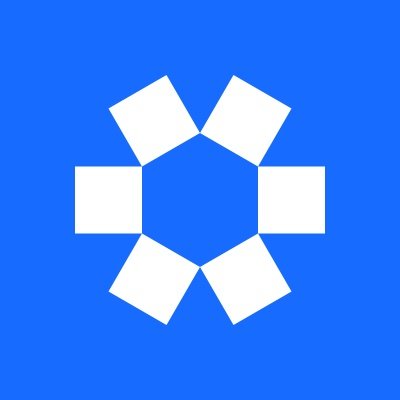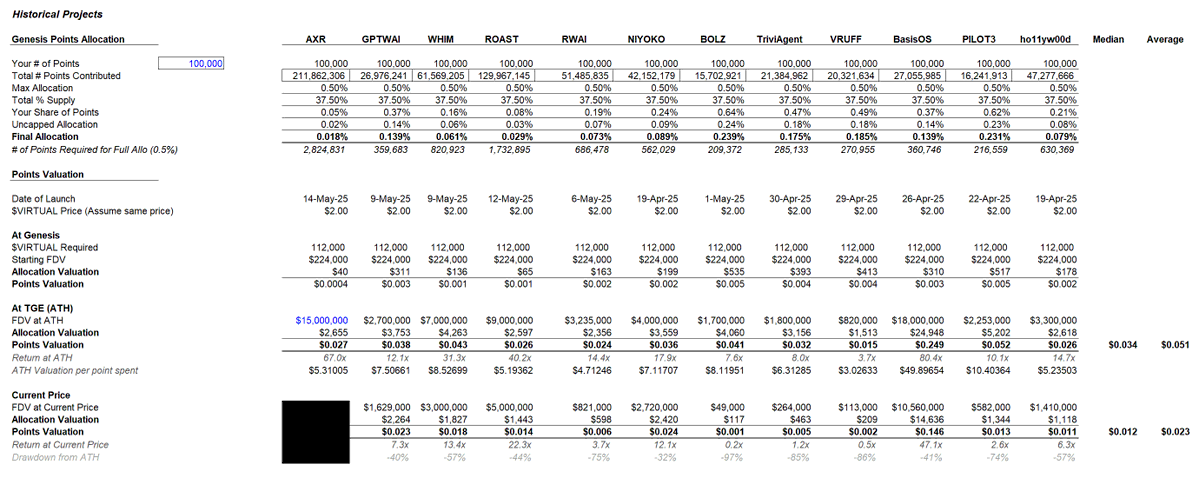
ARB
Arbitrum-pris
$0,43110
+$0,0075000
(+1,77 %)
Prisförändring de senaste 24 timmarna

Hur känner du för ARB idag?
Dela dina känslor här genom att göra tummen upp om du känner dig bullish för coin eller tummen ner om du känner dig bearish.
Rösta för att visa resultat
Friskrivningsklausul
Det sociala innehållet på den här sidan ("Innehållet"), inklusive men inte begränsat till tweets och statistik som tillhandahålls av LunarCrush, kommer från tredje part och tillhandahålls " i befintligt skick" och endast i informationssyfte. OKX garanterar inte innehållets kvalitet eller sanningshalt, och innehållet representerar inte OKX:s åsikter. Det är inte avsett att tillhandahålla (i) investeringsrådgivning eller -rekommendationer; (ii) ett erbjudande eller en uppmaning att köpa, sälja eller inneha digitala tillgångar; eller (iii) finansiell, redovisnings-, juridisk eller skatterådgivning. Digitala tillgångar, inklusive stabil kryptovaluta och NFT:er, innebär en hög grad av risk och kan fluktuera kraftigt. Priset och prestandan för den digitala tillgången är inte garanterade och kan ändras utan föregående meddelande.<br>OKX tillhandahåller inga rekommendationer om investeringar eller tillgångar. Du bör noga överväga om handel eller innehav av digitala tillgångar är lämpligt för dig, med tanke på din ekonomiska situation. Vänligen rådfråga en juridisk-/skatte-/investeringsrådgivare för frågor om just dina specifika omständigheter. För mer information, vänligen se våra <a href="/help/terms-of-service">Användarvillkor</a> och <a href="/help/risk-compliance-disclosure">Riskvarning</a>. Genom att använda tredjepartswebbplatsen (”third-party website/TPW”) godkänner du att all användning av TPW kommer att omfattas av och regleras av villkoren i TPW. Om inte annat uttryckligen anges skriftligen är OKX och dess dotterbolag ( OKX ) inte på något sätt associerade med ägaren eller operatören av TPW. Du samtycker till att OKX inte är ansvarigt eller skyldigt för någon förlust, skada eller andra konsekvenser som uppstår på grund av din användning av TPW. Vänligen observera om att användning av en TPW kan resultera i förlust eller minskning av dina tillgångar. Produkten kanske inte är tillgänglig i alla jurisdiktioner.
Arbitrum marknadsinfo
Marknadsvärde
Marknadsvärde beräknas genom att multiplicera det cirkulerande utbudet av ett coin med dess senaste pris.
Börsvärde = Cirkulerande utbud × Senaste pris
Börsvärde = Cirkulerande utbud × Senaste pris
Cirkulerande utbud
Totalt belopp för ett coin som är allmänt tillgängligt på marknaden.
Marknadsvärde-rankning
Ett coins rankning i termer av marknadsvärde.
Högsta någonsin
Högsta pris ett coin har nått i sin handelshistorik.
Lägsta någonsin
Lägsta pris ett coin har nått i sin handelshistorik.
Marknadsvärde
$2,06B
Cirkulerande utbud
4 756 695 618 ARB
47,56 % av
10 000 000 000 ARB
Marknadsvärde-rankning
--
Granskningar

Senaste granskningen: 9 nov. 2021
Högsta priset under 24 tim
$0,46470
Lägsta priset under 24 tim
$0,42050
Högsta någonsin
$2,4053
−82,08 % (-$1,9742)
Senast uppdaterad: 12 jan. 2024
Lägsta någonsin
$0,24200
+78,14 % (+$0,18910)
Senast uppdaterad: 7 apr. 2025
Arbitrum-flödet
Följande innehåll är hämtat från .

MR SHIFT 🦁
Vad är @Ethereum – och hur hjälper @arbitrum?
Föreställ dig en dator som vem som helst i världen kan använda - och lita på - för att köra vad som helst där riktiga pengar står på spel. Det är Ethereum.
Men som @sgoldfed från @OffchainLabs uttrycker det var Ethereum en kraftfull idé som kördes på en liten maskin: en med datorkraften hos en bärbar dator.
Om du vill driva alla världens transaktioner behöver du något större.
Det är vad Arbitrum bygger: en skalbar och pålitlig version av den globala datorn
Visa original403
0

Omni Network
Axal har integrerat Omni SolverNet på mainnet 🎉
Verifierbara agenter omformar krypto, men komplexitet över kedjan håller fortfarande användarna tillbaka. Tack vare SolverNet kan användare nu sätta in från Arbitrum, Optimism och Ethereum L1 direkt till @getaxal:s Autopilot.
Visa original4,22 tn
31

Investooor delade inlägget

0xJeff
Virgen Points — @virtuals_io Genesis lanserar trender
- # poäng som krävs för max allo fortsätter att öka från 200-600k poäng per projekt till 800k-1,7 miljoner i senaste projekt (Whimbet & Burnie)
- @AIxVC_Axelrod blir det mest hypade projektet med redan 211 miljoner poäng inlämnade redan (med ca 2 timmar kvar till slutet av försäljningen). Du måste spendera nära 3 miljoner poäng för att få maximal allo.
- Det är inte meningsfullt att spendera poäng här eftersom avkastningen per spenderad poäng sannolikt kommer att vara låg.
Jag har samlat in avkastningen per spenderad poäng baserat på beräkning av ATH-värdering per spenderad poäng (med uppskattad FDV på 15 miljoner dollar dividerat med det totala antalet bidragna poäng) - att köpa på TGE kan ge bättre inträde eftersom endast de främsta bidragsgivarna som bidrar med miljontals poäng får en betydande mängd utbud (0,5 %)
- I allmänhet är varje Virgen-poäng värd mellan $0,012 - $0,034 per poäng. Prispunkten för poängen ligger kvar på ett gediget intervall MEN mängden poäng som bidrar till projekt fortsätter att öka i snabb takt = du får mindre tilldelning i varje ny hypad lansering = lägre ingångsstorlek
- Skulle max låsa din $VIRTUAL till veVIRTUAL hjälp? Det skulle det definitivt. Till en början gick 15-19 miljoner punkter per dag till alla $VIRTUAL som hölls i omlopp (650 miljoner tokens). Nu går samma antal poäng till 1,35 miljoner veVIRTUAL (du gör matematiken lol)
- Är det vettigt att maxlåsa i 2 år? Detta beror verkligen på din övertygelse om ekosystemet.
Om du tror att Virtuals kan fortsätta att ta in byggare för att lansera unika projekt på Genesis Launch under en längre tid, och du kan få mer värde än det belopp du satsade, så visst.
Om inte, är det bättre att hålla din $VIRTUAL stack flytande ELLER låsa den under en kortare tid ELLER bara maxlåsa en liten del av din $VIRTUAL stack
Ha kul när du gräver diken Virgens
Jag kommer att dela med mig av min strategi för hur jag planerar att spela detta senare på min Substack för de som är intresserade
(Analysen utgår från samma $VIRTUAL pris för alla projekt för att utesluta effekten av $VIRTUAL pris på projektens ROI)


0xJeff
Glad att se fler DeFi-projekt som bygger AI-produkter och använder @virtuals_io som distribution efter framgången med @BasisOS
- Jarvis av @fractality_fi (tidigare Y2K Finance - lanserade en av de mest unika produkterna under Arb szn: exotiska derivat för knutna tillgångar, vilket låter användare satsa på undergången eller säkra sig mot stablecoins depeg)
Teamet svängde förra året till Fractality och fokuserade på basis-yield-strategivalv (liknande vibbar som BasisOS / Ethena). Jarvis verkar vara ett DeFAI-abstraktionslager för åtgärder på kedjan, särskilt överbryggning över kedjan, i syfte att driva mer TVL till Fractality-valv.
Jarvis lanseras på Genesis Launch om ungefär en timme (produkten är dock ännu inte ute).
- @Maneki_DeFi av @rivoxyz (tidigare Locus Finance - on-chain-index som erbjuder bästa DeFi-avkastning + ett av de bästa UI/UX för att introducera normies i DeFi)
Teamet vände sig till Rivo / Maneki, ett DeFAI-abstraktionslager med fokus på portföljoptimering, dvs. Agenten känner igen dina innehav och föreslår strategier för att optimera dina stablecoins, majors, etc., så att outnyttjat kapital inte bara sitter runtomkring.
Maneki lanseras på Genesis Launch om ungefär en vecka (stängd beta av produkten är live för dig att leka med).
Hoppas att se fler och fler DeFi-projekt lansera AI-produkter snart!
Disclaimer: Stöder inte något här, bara ser en trend. NFA / DYOR om du bestämmer dig för att apa lol
13,78 tn
101

Allen Ng
De flesta projekt vill ha din uppmärksamhet, men uppmärksamhet är inte gratis. och tbh många projekt är inte ens värt det
@TREX_chain:s $arb-drivna proof-of-engagement-webbtillägg betalar dig bokstavligen för det
Märk mina ord: T-Rex kan sätta den nya standarden inom Web3 och därefter
var uppmärksam bro🦖
Visa original
1,9 tn
3

0xJeff
Glad att se fler DeFi-projekt som bygger AI-produkter och använder @virtuals_io som distribution efter framgången med @BasisOS
- Jarvis av @fractality_fi (tidigare Y2K Finance - lanserade en av de mest unika produkterna under Arb szn: exotiska derivat för knutna tillgångar, vilket låter användare satsa på undergången eller säkra sig mot stablecoins depeg)
Teamet svängde förra året till Fractality och fokuserade på basis-yield-strategivalv (liknande vibbar som BasisOS / Ethena). Jarvis verkar vara ett DeFAI-abstraktionslager för åtgärder på kedjan, särskilt överbryggning över kedjan, i syfte att driva mer TVL till Fractality-valv.
Jarvis lanseras på Genesis Launch om ungefär en timme (produkten är dock ännu inte ute).
- @Maneki_DeFi av @rivoxyz (tidigare Locus Finance - on-chain-index som erbjuder bästa DeFi-avkastning + ett av de bästa UI/UX för att introducera normies i DeFi)
Teamet vände sig till Rivo / Maneki, ett DeFAI-abstraktionslager med fokus på portföljoptimering, dvs. Agenten känner igen dina innehav och föreslår strategier för att optimera dina stablecoins, majors, etc., så att outnyttjat kapital inte bara sitter runtomkring.
Maneki lanseras på Genesis Launch om ungefär en vecka (stängd beta av produkten är live för dig att leka med).
Hoppas att se fler och fler DeFi-projekt lansera AI-produkter snart!
Disclaimer: Stöder inte något här, bara ser en trend. NFA / DYOR om du bestämmer dig för att apa lol

0xJeff
Ytterligare tankar om Virtuals Genesis Launch / Virgen Points
Det visar sig att @RWAIAgent spelbok fungerar - att allokera en liten del av tokenomics till KOL:er vid >5x start av FDV med några låsningar och partiell upplåsning vid TGE.
Slutresultat: 1 074% övertecknat med ~50 miljoner poäng som bidrog till försäljningen. Om du lägger in 100k poäng får du bara 0,08%. För att maximera tilldelningen (0,5 %) på RWAI behöver du 650 000 poäng (jämfört med 350 000 poäng för NIYOKO för att få maximal allo).
Effekten av jeet jail-spektakel i kombination med privat runda KOL-hype blåser upp det totala antalet poäng, vilket lämnar små detaljhandelsaktörer med minimala tilldelningar.
Fördelen är att ingen förlorar pengar på försäljningen.
Nackdelen: om buggen inte åtgärdas snart kanske det inte är värt alternativkostnaden att spela det här Genesis-spelet. Det är bättre att backa upp solida agentteam med beprövade produkter och meriter.
RWAI-spelboken kommer sannolikt att replikeras mer, men den här gången med virtuella KOL:er som får tilldelningar (istället för utomstående). Förhoppningsvis kommer detta med mer transparens kring tokenomics.
Den nuvarande iterationen av startplattan gör det svårt för större projekt att lansera – de kan inte ta in från riskkapitalister eller strategier till höga värderingar (för landningsbana och drift).
^ Det enda genomförbara alternativet nu: lansera två tokens – en agenttoken som representerar AI-agenten och en ekosystemtoken som samlar på sig majoriteten av intäktsströmmarna. (Men den här modellen är inte hållbar på lång sikt, eftersom airdrop av eco-token för att hålla communityn nöjd ofta leder till dumpning av AI-agenttoken.)
Men... vem vet, vi kanske ser fler framgångshistorier om små team som når $100m+ värderingar från lansering på Genesis, och större team som lanserar AI-agenttokens med en produkt som kan upprätthålla PA för båda tokens.
Genesis-lanseringar kan vara en guldgruva - bara om du spelar allokeringsspelet strategiskt
Obs: Jag har mörklagt avsnittet till höger eftersom jag inte har historiska datapunkter för "Totalt # Bidrag poäng", så jag kunde inte beräkna poängvärderingar för tidigare projekt. Om du har dessa uppgifter, skulle uppskatta det om du kunde dela - t.ex. för BasisOS, Triviagent, ho11yw00d och andra hypade lanseringar.

23,77 tn
77
ARB-kalkylator


Arbitrum prisutveckling i USD
Aktuellt pris på Arbitrum är $0,43110. Under de senaste 24 timmarna har Arbitrum ökade med +1,77 %. Det har för närvarande ett cirkulerande utbud av 4 756 695 618 ARB och ett maximalt utbud av 10 000 000 000 ARB, vilket ger ett marknadsvärde efter full utspädning på $2,06B. För tillfället innehar Arbitrum-coin position 0 i marknadsvärdesrankningar. Arbitrum/USD-priset uppdateras i realtid.
Idag
+$0,0075000
+1,77 %
7 dagar
+$0,12490
+40,79 %
30 dagar
+$0,12570
+41,15 %
3 månader
-$0,05690
−11,66 %
Populära Arbitrum-omvandlingar
Senast uppdaterad: 2025-05-14 22:09
| 1 ARB till USD | 0,43230 $ |
| 1 ARB till EUR | 0,38540 € |
| 1 ARB till PHP | 24,1513 ₱ |
| 1 ARB till IDR | 7 154,92 Rp |
| 1 ARB till GBP | 0,32465 £ |
| 1 ARB till CAD | 0,60342 $ |
| 1 ARB till AED | 1,5879 AED |
| 1 ARB till VND | 11 214,01 ₫ |
Om Arbitrum (ARB)
Betyget som anges är ett sammanställt betyg som inhämtats av OKX från källorna som anges, och det anges endast för informativa syften. OKX garanterar inte betygens kvalitet eller korrekthet. Det är inte avsett att utgöra (i) investeringsrådgivning eller rekommendation, (ii) ett erbjudande eller en uppmaning att köpa, sälja eller inneha digitala tillgångar, eller (iii) finansiell, redovisningsmässig, juridisk eller skattemässig rådgivning. Digitala tillgångar, inklusive stabil kryptovaluta och NFT:er, omfattas av hög risk, kan skifta kraftigt och till och med bli värdelösa. Priset och prestanda för de digitala tillgångarna garanteras inte, och de kan förändras utan föregående meddelande. Dina digitala tillgångar täcks inte av försäkran mot potentiella förluster. Historisk avkastning är ingen garanti om framtida avkastning. OKX garanterar inte någon avkastning, återbetalning av huvudbelopp eller ränta. OKX tillhandahåller inga rekommendationer om investeringar eller tillgångar. Du bör noga överväga om handel med eller innehav av digitala tillgångar är lämpligt för dig med hänsyn till din ekonomiska situation. Rådgör med din jurist, skatteexpert eller investeringsrådgivare om du har frågor om dina specifika omständigheter.
Visa mer
- Officiell webbplats
- Github
- Block explorer
Om tredjeparts webbplatser
Om tredjeparts webbplatser
Genom att använda tredjepartswebbplatsen (”TPW”) samtycker du till att all användning av TPW kommer att omfattas av och styras av villkoren i TPW. Om inte annat uttryckligen anges skriftligen är OKX och dess affiliates (”OKX”) inte på något sätt associerade med ägaren eller operatören av TPW. Du samtycker till att OKX inte är ansvarigt eller skadeståndsskyldigt för förlust, skada eller andra konsekvenser som uppstår till följd av din användning av TPW. Var medveten om att användning av en TPW kan leda till förlust eller minskning av dina tillgångar.
Vanliga frågor för Arbitrum
Hur mycket är 1 Arbitrum värd idag?
För närvarande är en Arbitrum värd $0,43110. För svar och insikt om prisåtgärder för Arbitrum är du på rätt plats. Utforska de senaste diagrammen för Arbitrum och handla ansvarsfullt med OKX.
Vad är kryptovalutor?
Kryptovalutor, till exempel Arbitrum, är digitala tillgångar som fungerar på en offentlig reskontra som kallas blockkedjor. Läs mer om coins och tokens som erbjuds på OKX och deras olika attribut, som inkluderar live-priser och realtidsdiagram.
När uppfanns kryptovalutor?
Tack vare finanskrisen 2008 ökade intresset för decentraliserad finansiering. Bitcoin erbjöd en ny lösning genom att vara en säker digital tillgång på ett decentraliserat nätverk. Sedan dess har många andra tokens som t.ex. Arbitrum skapats också.
Kommer priset på Arbitrum gå upp idag?
Se vår Arbitrum prisprognossida för att förutse framtida priser och fastställa dina prismål.
ESG-upplysning
ESG-regleringar (Environmental, Social och Governance) för kryptotillgångar syftar till att ta itu med eventuell miljöpåverkan (t.ex. energiintensiv mining), främja transparens och säkerställa etiska förvaltningsmetoder för att anpassa kryptoindustrin till bredare hållbarhets- och samhälleliga mål. Dessa regleringar uppmuntrar efterlevnad av standarder som minskar risker och främjar förtroende för digitala tillgångar.
Tillgångsdetaljer
Namn
OKcoin Europe LTD
Relevant juridisk enhetsidentifierare
54930069NLWEIGLHXU42
Namn på kryptotillgången
Arbitrum
Konsensusmekanism
Arbitrum is present on the following networks: arbitrum, ethereum.
Arbitrum is a Layer 2 solution on top of Ethereum that uses Optimistic Rollups to enhance scalability and reduce transaction costs. It assumes that transactions are valid by default and only verifies them if there's a challenge (optimistic): Core Components: • Sequencer: Orders transactions and creates batches for processing. • Bridge: Facilitates asset transfers between Arbitrum and Ethereum. • Fraud Proofs: Protect against invalid transactions through an interactive verification process. Verification Process: 1. Transaction Submission: Users submit transactions to the Arbitrum Sequencer, which orders and batches them. 2. State Commitment: These batches are submitted to Ethereum with a state commitment. 3. Challenge Period: Validators have a specific period to challenge the state if they suspect fraud. 4. Dispute Resolution: If a challenge occurs, the dispute is resolved through an iterative process to identify the fraudulent transaction. The final operation is executed on Ethereum to determine the correct state. 5. Rollback and Penalties: If fraud is proven, the state is rolled back, and the dishonest party is penalized. Security and Efficiency: The combination of the Sequencer, bridge, and interactive fraud proofs ensures that the system remains secure and efficient. By minimizing on-chain data and leveraging off-chain computations, Arbitrum can provide high throughput and low fees.
The Ethereum network uses a Proof-of-Stake Consensus Mechanism to validate new transactions on the blockchain. Core Components 1. Validators: Validators are responsible for proposing and validating new blocks. To become a validator, a user must deposit (stake) 32 ETH into a smart contract. This stake acts as collateral and can be slashed if the validator behaves dishonestly. 2. Beacon Chain: The Beacon Chain is the backbone of Ethereum 2.0. It coordinates the network of validators and manages the consensus protocol. It is responsible for creating new blocks, organizing validators into committees, and implementing the finality of blocks. Consensus Process 1. Block Proposal: Validators are chosen randomly to propose new blocks. This selection is based on a weighted random function (WRF), where the weight is determined by the amount of ETH staked. 2. Attestation: Validators not proposing a block participate in attestation. They attest to the validity of the proposed block by voting for it. Attestations are then aggregated to form a single proof of the block’s validity. 3. Committees: Validators are organized into committees to streamline the validation process. Each committee is responsible for validating blocks within a specific shard or the Beacon Chain itself. This ensures decentralization and security, as a smaller group of validators can quickly reach consensus. 4. Finality: Ethereum 2.0 uses a mechanism called Casper FFG (Friendly Finality Gadget) to achieve finality. Finality means that a block and its transactions are considered irreversible and confirmed. Validators vote on the finality of blocks, and once a supermajority is reached, the block is finalized. 5. Incentives and Penalties: Validators earn rewards for participating in the network, including proposing blocks and attesting to their validity. Conversely, validators can be penalized (slashed) for malicious behavior, such as double-signing or being offline for extended periods. This ensures honest participation and network security.
Incitamentmekanismer och tillämpliga avgifter
Arbitrum is present on the following networks: arbitrum, ethereum.
Arbitrum One, a Layer 2 scaling solution for Ethereum, employs several incentive mechanisms to ensure the security and integrity of transactions on its network. The key mechanisms include: 1. Validators and Sequencers: o Sequencers are responsible for ordering transactions and creating batches that are processed off-chain. They play a critical role in maintaining the efficiency and throughput of the network. o Validators monitor the sequencers' actions and ensure that transactions are processed correctly. Validators verify the state transitions and ensure that no invalid transactions are included in the batches. 2. Fraud Proofs: o Assumption of Validity: Transactions processed off-chain are assumed to be valid. This allows for quick transaction finality and high throughput. o Challenge Period: There is a predefined period during which anyone can challenge the validity of a transaction by submitting a fraud proof. This mechanism acts as a deterrent against malicious behavior. o Dispute Resolution: If a challenge is raised, an interactive verification process is initiated to pinpoint the exact step where fraud occurred. If the challenge is valid, the fraudulent transaction is reverted, and the dishonest actor is penalized. 3. Economic Incentives: o Rewards for Honest Behavior: Participants in the network, such as validators and sequencers, are incentivized through rewards for performing their duties honestly and efficiently. These rewards come from transaction fees and potentially other protocol incentives. o Penalties for Malicious Behavior: Participants who engage in dishonest behavior or submit invalid transactions are penalized. This can include slashing of staked tokens or other forms of economic penalties, which serve to discourage malicious actions. Fees on the Arbitrum One Blockchain 1. Transaction Fees: o Layer 2 Fees: Users pay fees for transactions processed on the Layer 2 network. These fees are typically lower than Ethereum mainnet fees due to the reduced computational load on the main chain. o Arbitrum Transaction Fee: A fee is charged for each transaction processed by the sequencer. This fee covers the cost of processing the transaction and ensuring its inclusion in a batch. 2. L1 Data Fees: o Posting Batches to Ethereum: Periodically, the state updates from the Layer 2 transactions are posted to the Ethereum mainnet as calldata. This involves a fee, known as the L1 data fee, which accounts for the gas required to publish these state updates on Ethereum. o Cost Sharing: Because transactions are batched, the fixed costs of posting state updates to Ethereum are spread across multiple transactions, making it more cost-effective for users.
Ethereum, particularly after transitioning to Ethereum 2.0 (Eth2), employs a Proof-of-Stake (PoS) consensus mechanism to secure its network. The incentives for validators and the fee structures play crucial roles in maintaining the security and efficiency of the blockchain. Incentive Mechanisms 1. Staking Rewards: Validator Rewards: Validators are essential to the PoS mechanism. They are responsible for proposing and validating new blocks. To participate, they must stake a minimum of 32 ETH. In return, they earn rewards for their contributions, which are paid out in ETH. These rewards are a combination of newly minted ETH and transaction fees from the blocks they validate. Reward Rate: The reward rate for validators is dynamic and depends on the total amount of ETH staked in the network. The more ETH staked, the lower the individual reward rate, and vice versa. This is designed to balance the network's security and the incentive to participate. 2. Transaction Fees: Base Fee: After the implementation of Ethereum Improvement Proposal (EIP) 1559, the transaction fee model changed to include a base fee that is burned (i.e., removed from circulation). This base fee adjusts dynamically based on network demand, aiming to stabilize transaction fees and reduce volatility. Priority Fee (Tip): Users can also include a priority fee (tip) to incentivize validators to include their transactions more quickly. This fee goes directly to the validators, providing them with an additional incentive to process transactions efficiently. 3. Penalties for Malicious Behavior: Slashing: Validators face penalties (slashing) if they engage in malicious behavior, such as double-signing or validating incorrect information. Slashing results in the loss of a portion of their staked ETH, discouraging bad actors and ensuring that validators act in the network's best interest. Inactivity Penalties: Validators also face penalties for prolonged inactivity. This ensures that validators remain active and engaged in maintaining the network's security and operation. Fees Applicable on the Ethereum Blockchain 1. Gas Fees: Calculation: Gas fees are calculated based on the computational complexity of transactions and smart contract executions. Each operation on the Ethereum Virtual Machine (EVM) has an associated gas cost. Dynamic Adjustment: The base fee introduced by EIP-1559 dynamically adjusts according to network congestion. When demand for block space is high, the base fee increases, and when demand is low, it decreases. 2. Smart Contract Fees: Deployment and Interaction: Deploying a smart contract on Ethereum involves paying gas fees proportional to the contract's complexity and size. Interacting with deployed smart contracts (e.g., executing functions, transferring tokens) also incurs gas fees. Optimizations: Developers are incentivized to optimize their smart contracts to minimize gas usage, making transactions more cost-effective for users. 3. Asset Transfer Fees: Token Transfers: Transferring ERC-20 or other token standards involves gas fees. These fees vary based on the token's contract implementation and the current network demand.
Början av den period som upplysningen avser
2024-04-20
Slutet av den period som upplysningen avser
2025-04-20
Energirapport
Energiförbrukning
2235.92294 (kWh/a)
Energiförbrukningskällor och -metoder
The energy consumption of this asset is aggregated across multiple components:
To determine the energy consumption of a token, the energy consumption of the network(s) arbitrum, ethereum is calculated first. Based on the crypto asset's gas consumption per network, the share of the total consumption of the respective network that is assigned to this asset is defined. When calculating the energy consumption, we used - if available - the Functionally Fungible Group Digital Token Identifier (FFG DTI) to determine all implementations of the asset of question in scope and we update the mappings regulary, based on data of the Digital Token Identifier Foundation.
ARB-kalkylator















Sociala medier